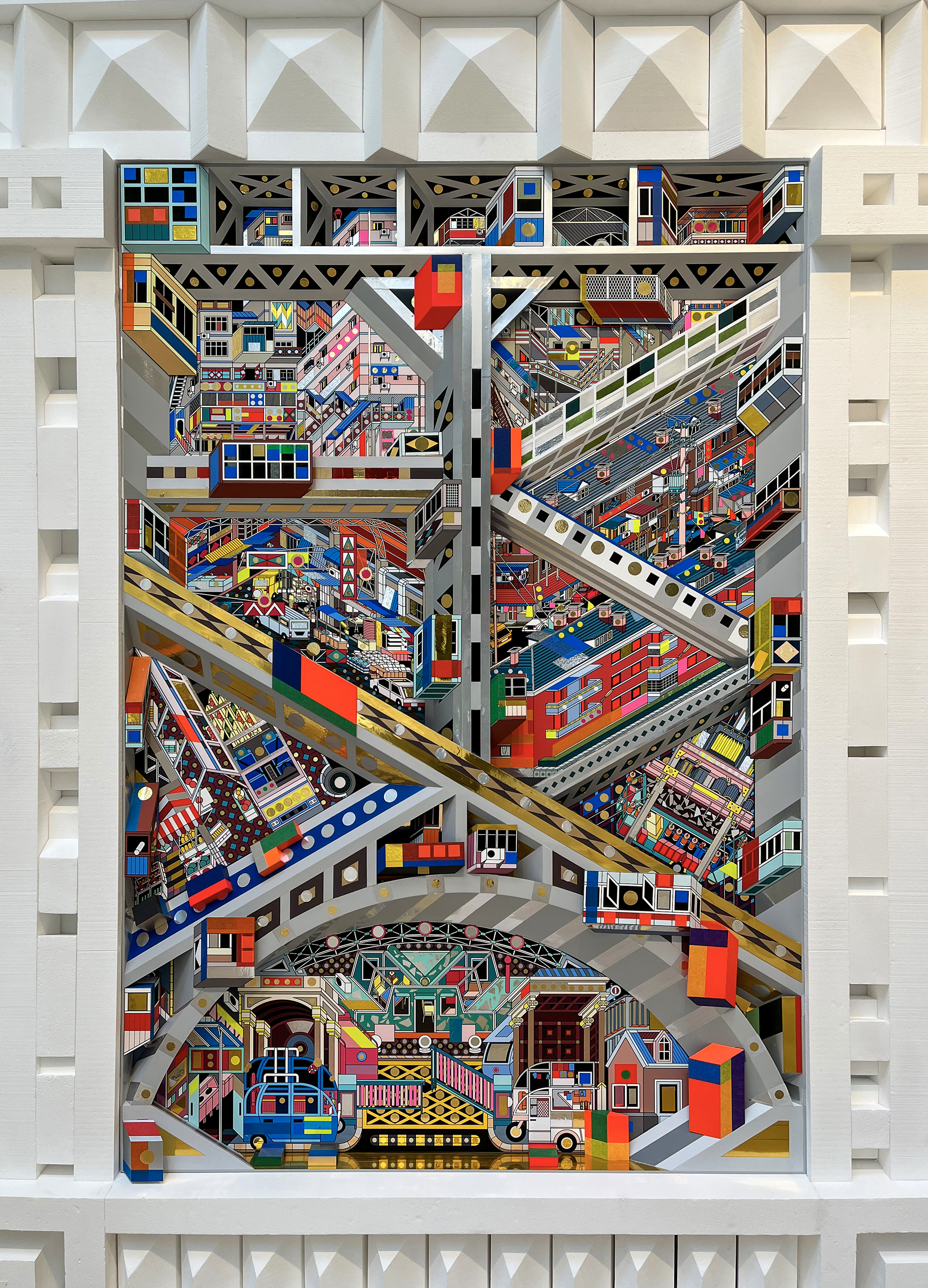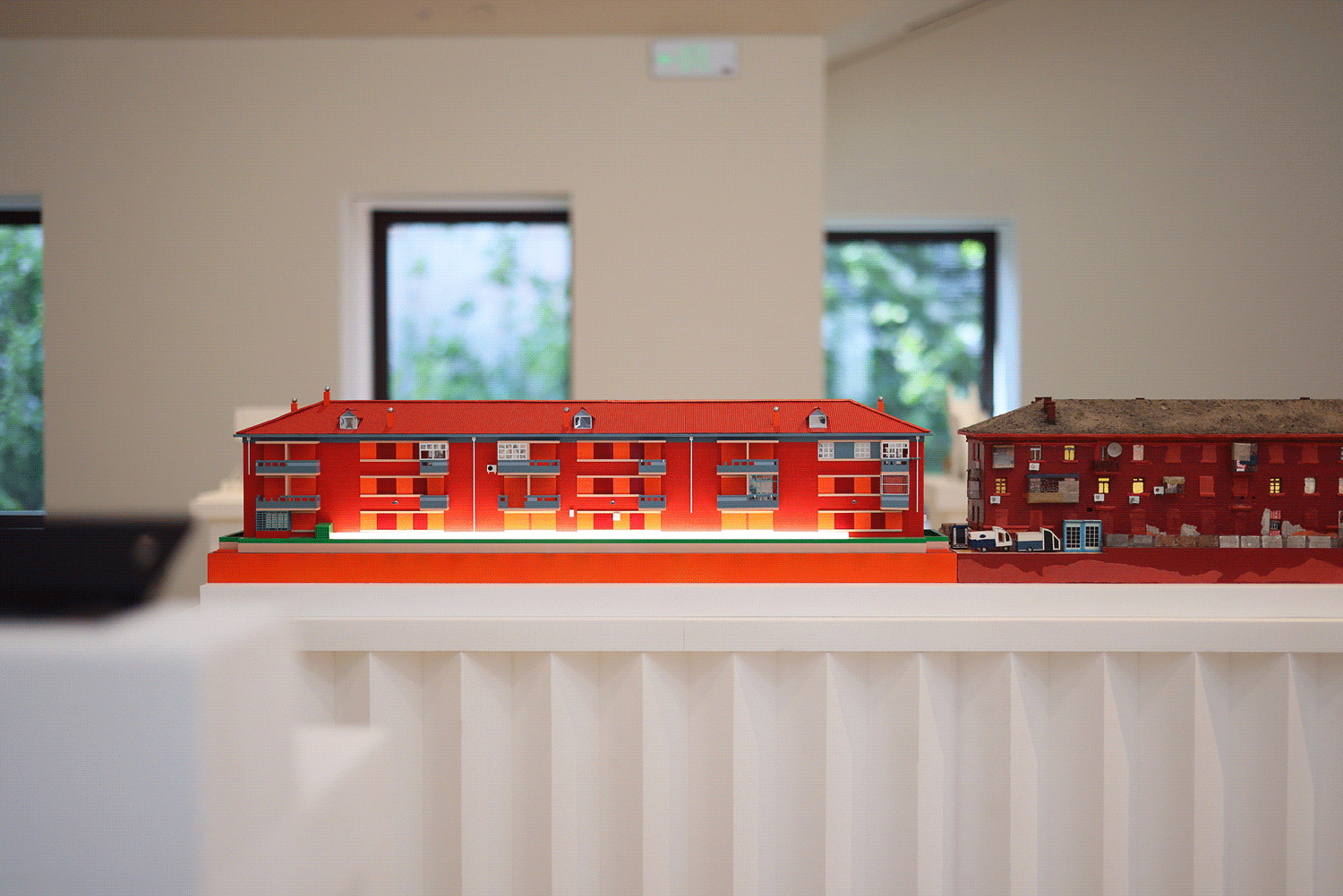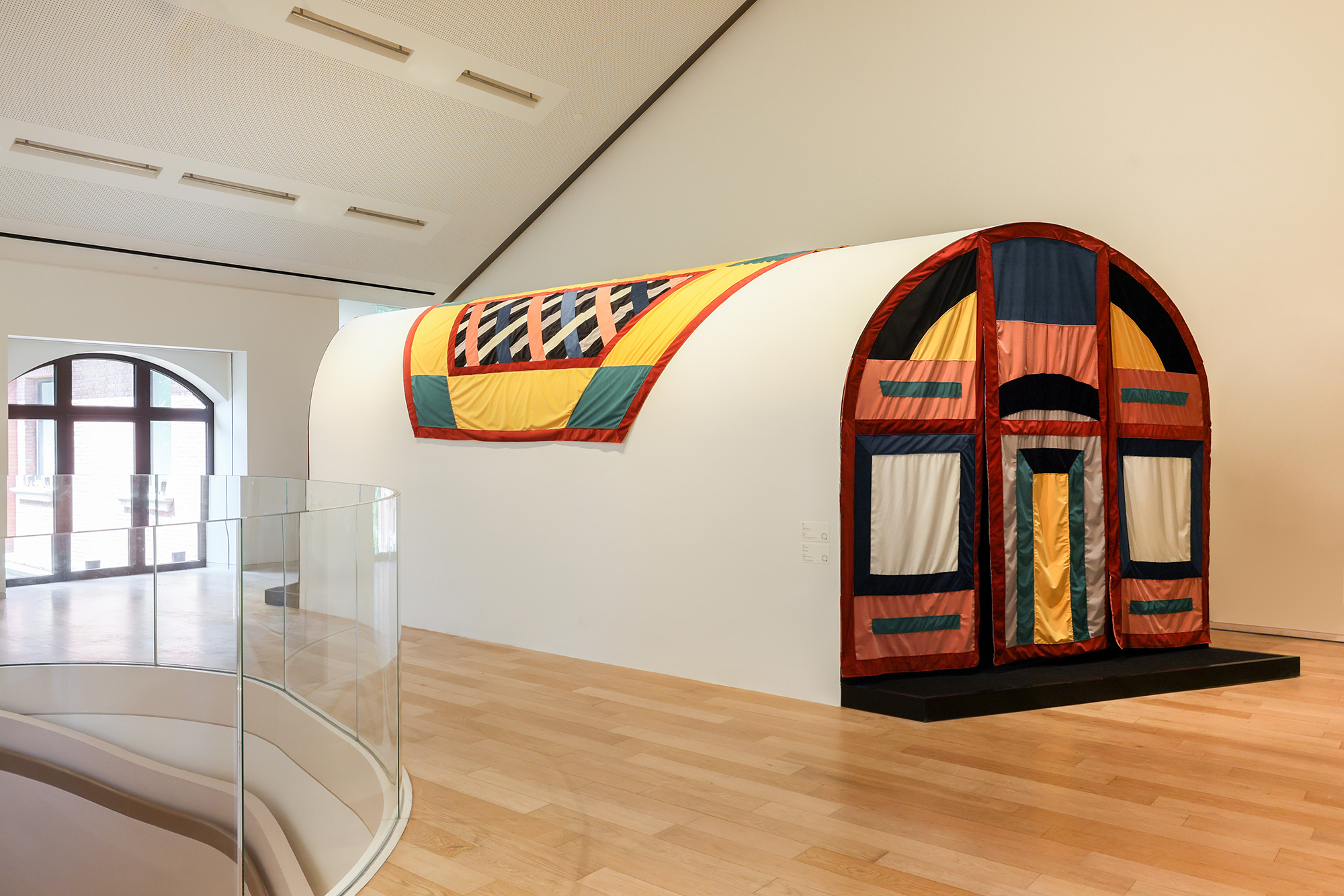受爱马仕邀请,绘造社主持人李涵为位于淮海中路217号的上海“爱马仕之家”创作了全新的2023年夏季橱窗《仕物别景》。同时,作为本季橱窗设计的延展,李涵的个人艺术展《生活模型》于2023年5月25日至6月11日在上海“爱马仕之家”四楼展出。
Invited by Hermès, Li Han, Principal of Drawing Architecture Studio, created a brand new 2023 summer window Scape of Urban Object for the Hermès Maison in Shanghai, located in No.217 Middle Huaihai Road. At the same time, as a continuity of this season's window display, Li Han's solo exhibition Life Models will be exhibited on the 4th floor of the Hermès Maison in Shanghai from May 25 to June 11, 2023.

日常生活中的多样物件——巴士、自动贩卖机、公交站、广告牌、变电箱、电线杆、消防水箱,构成了城市生活的基础性符码。李涵以这些日常城市物为灵感,对它们展开富有想象力的艺术变形与重构,通过极具表现力的色彩与景别调度,为本季橱窗搭构出充满戏剧性的都市拟象。通过8组造型奇异的装置,李涵挖掘了平凡物件在都市生活中的多重意义,引领观者转换视角,透过重组而成的建筑窥看城市生活的肌理,再次审视身边的一切。
Various objects in daily life, e.g., buses, vending machines, bus stops, billboards, electric boxes, utility poles, fire water tanks, constitute the basic codes of urban life. Inspired by these everyday urban objects, Li Han carried out imaginative artistic deformation and reconstruction of them, and through expressive color and staging, he constructed a dramatic urban simulacrum for this season's window. Through 8 sets of spectacularly shaped installations, Li Han excavated the multiple meanings of ordinary objects in urban life, leading the viewers to change their perspectives, see the texture of urban life through the reconstructed buildings, and re-examine everything around them.



李涵个人艺术展《生活模型》,由鲍栋策展,展出了李涵在近两年创作的最新作品,吸引公众深入探索建筑与生活千丝万缕的紧密联结。在此次展览中,李涵以建筑师独特的创作方式,阐释了个人对生活的思索观察与感悟。个体与群体,市井与都市,过去与未来,现实与理想……蕴藏于都市建筑中的种种对立特质经过有机整合,将身边的城市角落演绎为有关都市众生的艺术场景。
Li Han's solo exhibition Life Models, curated by Bao Dong, exhibits Li Han's latest works created in the past two years, engaging the visitors to explore the close connection between architecture and life. In this exhibition, Li Han displays his observation and understanding of life with his unique creation method as an architect. Individuality and community, local and metropolitan, past and future, reality and dream……, all kinds of contradictory characteristics contained in urban architecture are organically integrated, interpreting the surrounding city corners as artistic scenes about urban life.




《龙剧院》是对中国城市奇观的想象。这件作品取材于一个真实的场景:一座位于重庆某停车楼里的川剧院。李涵围绕这个真实场景展开空间想象,构想出一则传奇故事。故事演化也带动了一系列更加神奇的场景产生。《龙剧院》继承了叙事建筑的传统,以一种个人化的视角来建构空间场所。装置既是一个建筑模型,也是一个定格动画的拍摄舞台。故事中所有的场景被无缝整合在一起,这也正是高密度城市的神奇所在。
Dragon Theater is an imagination of the wonders of Chinese cities. The work is based on a real setting: a Sichuan opera theater located in a parking garage in Chongqing. Li Han imagined around this real scene and conceived a legendary story. The evolution of the story also led to a series of more magical scenes. Dragon Theater inherits the tradition of narrative architecture and constructs space and places with a personal perspective. The installation is not only an architectural model, but also a stop-motion animation shooting stage. All the scenes in the story are seamlessly integrated, which is as well the magic of high-density cities.




《鸽子笼》的原型是已被拆除的上海网红建筑兴德鸽舍。这件作品体现了“鸽子笼”一词的丰富含义:它既指居民为养鸽子而搭建的小窝棚,也是对昂贵的大都市中狭小的个人生活空间的隐喻。李涵以1:4的比例还原了这幢充满民间想象力和世俗气息的建筑外观。它的室内是这个复杂外观的空间负形。在纯白的空间中,顶部的彩色玻璃窗投射出五彩斑斓的光影,让参观者进入一个纯净的精神空间。这件作品内外的巨大反差也体现了都市人的精神世界与现实空间之间复杂的矛盾。
The prototype of Pigeon Cage Chapel is Xingde Pigeon House, an Instagrammable building in Shanghai that has been demolished. The work embodies the rich meaning of the words "pigeon cage": it does not only refer to the small shacks built by residents to keep pigeons, but is also a metaphor for the small personal living space in expensive metropolises. Li Han restored the appearance of this building full of folk imagination and secular atmosphere with a scale of 1:4. The interior is the spatial negative of its intricate exterior. In the pure white space, the stained-glass windows on the top project colorful light and shadow, inviting visitors to enter a pure spiritual space. The huge contrast between the inside and outside of the work also reflects the complex contradiction between the spiritual world of the urbanites and the real space.


《理想城市》不仅是壁画,也是浮雕。墙壁原型来自爱马仕之家建筑中一处山墙,具有西方建筑经典的形式和比例。用EPS板制作的墙面肌理是对现代网格化城市的抽象。壁画和浮雕将市井空间的元素——建筑、道路、桥梁、市政设施、交通工具、生活用品进行高密度拼贴组合,以李涵独特的建筑制图方式进行全景式呈现。这些混乱复杂、充满烟火气的市井空间与墙壁象征的经典建筑和城市范式形成强烈对比,共同构成了一个理想城市。
Ideal City is not only a mural, but also a relief. The prototype of the wall comes from a gable wall in the Hermès Maison, which has the classic form and proportion of Western architecture. The wall texture made of EPS board is an abstraction of the modern grid city. The mural and reliefs combine the elements of the everyday space - buildings, roads, bridges, municipal facilities, transportation, and daily necessities - in a high-density collage, and present them in a panoramic manner with the artist's unique architectural drawing method. These chaotic and complex urban spaces filled with hustle and bustle are in sharp contrast to the classic architecture and urban paradigms symbolized by the wall, which altogether constitute an ideal city.



《成为纪念碑》展现了三栋建于1950年代的中国第一代社会住宅使用了70年后的样貌。飞速的城市化进程让三栋位于相同区域、具有相同功能的建筑,呈现出截然不同的使用状态。通过线性并置,作品呈现出建筑在漫长的时间中,实用性与纪念性、物质性与精神性的转变过程。
Becoming A Monument shows the appearance of three first-generation social housing in China built in the 1950s after 70 years of use. The rapid urbanization process makes the three buildings located in the same area and with the same function present completely different usage states. Through linear juxtaposition, the work reveals the transformation process of architecture over a long period of time, between practicality and monumentality, materiality and spirituality.


《家用机器城》是探讨可移动性与城市公共空间使用的系列作品。原本作为交通工具的机器经过改造,成为普通市民免费利用城市公共空间的工具。它们让个体居民得以用最低的成本扩展了在昂贵的大城市中的生活“领地”。《家用机器城》以一种夸张、荒诞和幽默的方式进一步拓展了这种城市现象的可能。作品为可移动概念附加了新的含义:移动不是为了改变位置,而是为了占据和使用某处空间。
City of Domestic Machine is a series of works exploring mobility and the use of urban public space. The machines that were originally used as means of transportation have been transformed into tools for ordinary citizens to use urban public spaces for free. They enable individual residents to extend their living "territories" in expensive metropolises at minimal cost. City of Domestic Machine further expands the possibility of this urban phenomenon in an exaggerated, absurd and humorous way. The work adds a new meaning to the concept of mobility: to move is not to change location, but is to occupy and use a certain space.





《洞》是窗洞,也是窑洞。它是西方古典建筑中拱窗的变体,也是中国传统民居窑洞的化身。《洞》也是一个迷你画廊,内部展示了本次展览的另一件作品《突然的风景》。
The Cave is a window hole, but also a Yao Dong (cave dwelling). It is a variant of the arch window in Western classical architecture, and also the embodiment of the traditional Chinese cave dwellings. The Cave is also a mini gallery, which displays another work of the exhibition Suddenly This View.


《突然的风景》是用模型进行城市写生的系列作品。通过比例为1:100的小模型,以快速、朴实、直接的方式记录下被无意一瞥发现的普通城市场景。这些不起眼的城市角落饱含着日常生活的诗意。《突然的风景》也是一组摄影作品,用观看城市风景的方式拍摄模型,将微观世界分毫毕现。
Suddenly This View is a series of urban sketches using models. Through small models with a scale of 1:100, ordinary urban scenes discovered by casual glances are recorded in a fast, simple and direct way. These humble city corners are filled with the poetry of everyday life. Suddenly This View is also a collection of photographic works, shooting models in the way of viewing urban landscapes, fully revealing the microscopic world.







《生活模型》探索了建筑模型作为一种独特的艺术媒介的可能。建筑模型除了作为建筑师的设计和表现工具,也可以作为一种独特的艺术品,在绘画、雕塑、装置这些传统艺术媒介中自由转换;同时作为一种平民化的媒介,它并不仅仅属于专业领域。从娃娃屋到积木玩具都可以视为模型的一种。在这个展览里,李涵也尝试以快速轻松的状态完成模型,模型可能就是一张三维的草图,写生或者漫画。
Life Models explores the possibilities of architectural models as a unique artistic medium. In addition to being a design and representational tool for architects, architectural models can also be regarded as a unique artwork, which can be freely converted between traditional art media such as painting, sculpture, and installation; at the same time, as a grass-root medium, it is not only a professional field. From dollhouses to building block toys can be regarded as a kind of model. In this exhibition, Li Han also tries to complete the model quickly and easily. The model may be a three-dimensional sketch, sketch or comic.
对李涵来说,做模型既是做建筑设计也是做艺术作品,就如同李涵本人介于建筑师和艺术家之间的模糊身份,展览中的作品也处于含混的,无法清晰定义的中间状态,但这点恰恰是这个展览最独特有趣的地方。
For Li Han, making models is both designing architecture and making art. Just like Li Han himself having a blurred identity between architect and artist, the works in the exhibition are also in an ambiguous state that cannot be clearly defined, but this is precisely the most unique and interesting aspect of this exhibition.



版权声明:本文由绘造社授权发布。欢迎转发,禁止以有方编辑版本转载。
投稿邮箱:media@archiposition.com
上一篇:危险之地的解药:FFB修道院 / Mixtura
下一篇:环廊游乐园:普洱市思茅区幼儿园南部分园 / 华工设计院 陶郅工作室